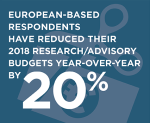Solvency II Rules Trigger Flood of Insurance Company Investments in Real Estate and Infrastructure Debt
January 16, 2018
One-third of continental European insurance companies expect to increase investment portfolio allocations to real estate and infrastructure in the next three years.










